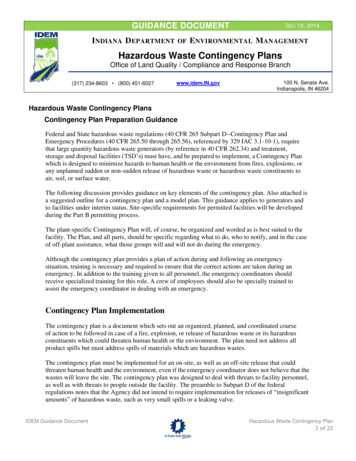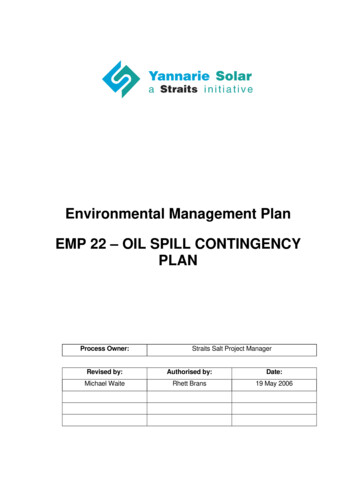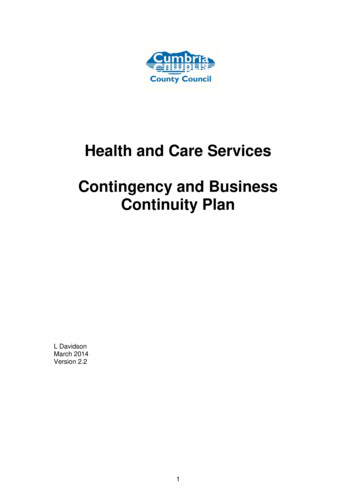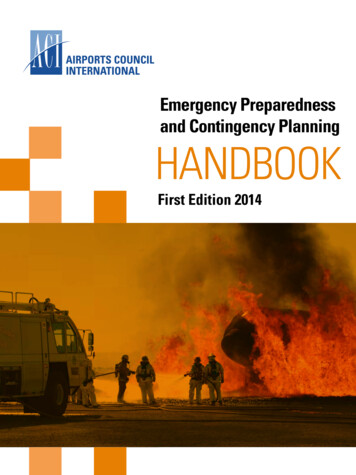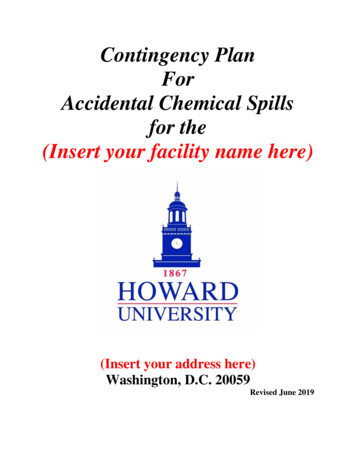
Transcription
Contingency PlanForAccidental Chemical Spillsfor the(Insert your facility name here)(Insert your address here)Washington, D.C. 20059Revised June 2019
Table of Contents1. Introduction . . Page 32. Spill Contingency Agency Response . Page 43. Action Plan . . Page 54. Resource Inventory . . Page 85. Training Program . . Page 86. Related Requirements . Page 117. Appendix . . Page 12A. Hazardous Substance InventoryB. Inspections LogC. Spill LogD. TrainingE. Important NumbersCompany Name: Howard UniversitySite Name: (insert your facility name here & also put anothername it is referenced by if applicable in parenthesis)Site Address: (insert your address here) Washington, D.C.20059Effective Date of Plan: April 30, 20162 Page
1. IntroductionSpills of petroleum products and other hazardous materials cannot be entirely prevented;however, the impacts of spills can be minimized by establishing a predetermined line of responseand action plan. The location of developments at the Howard University Campus and theenvironmental sensitivity of the region underline the necessity for good spill contingencyplanning.The purpose of this document is to provide guidance for the preparation of acceptable SpillContingency Plans. Howard University staff must be aware of the correct emergency proceduresto take in the event of a chemical spill. Chemical spills, whether toxic, reactive, flammable, orcorrosive even in small quantities can present a potential exposure hazard to staff. Corrosives,such as acids and caustics, can cause severe burns upon contact with skin and/or eyes, and thepresence of fumes can be damaging to the respiratory system. Many organic solvents areflammable and release vapors, which are irritating to the eyes and respiratory system.Scope of the contingency response plan for accidental chemical spill procedure at this facility isdesigned to handle the requirements for this system and associated hazardous substances, to stopthe source of the spill, contain any spilled material and clean up the spill in a timely manner toprevent accidental injury or other damage. Small spills will be contained by site personnel if theyare able to do so without risking injury. Spill kits are located at the following location(s).Personnel will properly characterize spill cleanup materials before disposal. For questions aboutdisposal call the Department of Environmental Health & Safety – Public Safety at (202) 8061033. Or if after hours call Campus Police Dispatch at 202-806-1100.List type and amount of Hazardous Substance Inventory materials normally stored on site, thestorage capacity and the type and number of storage containers. (See APPENDIX A –Hazardous Substance Inventory)Spill PreventionThe following are general requirements for any hazardous substances stored or used at thisfacility.General Requirements Ensure all hazardous substances are properly labeled. Store, dispense, and/or use hazardous substances in a way that prevents releases. Provide secondary containment when storing hazardous substances in bulk quantities ( 55g). Maintain good housekeeping practices for all chemical materials at the facility. Routine/Daily checks in the hazardous substance storage area to be performed by Monthly inspections of the hazardous substance storage area, secondary containment, andannular space (interior cavity of double wall tank) on any Above-ground Storage Tanks(AST) or Underground Storage Tanks (UST) need to be logged in this plan. (SeeAPPENDIX B - Inspection Log).3 Page
2. Spill Contingency Agency ResponseTitleCampus PoliceDirectorEnvironmentHealth & SafetySpecificDepartmentNameCampus PoliceDispatchNumber(s)Mr. Alfa Jackson(202) 806-1033TBD202-806-1100DutiesEnsure police presence for safety & crowd control; anyother emergency assistance as neededOn site to ensure Contingency plan is operating asrequired and to provide additional resources as neededfor containment/cleanup/abatement, etc.On scene coordinator, etc.Reporting.Incident reporting: Report any injury or exposure to your supervisor (needle stick, slip/trip/fall, chemicalspill). Receive medical attention, if applicable.Emergency Procedures: Immediately call Campus Police 202-806-1100 in the event of injury, fire or potentialfire, or spill of a hazardous substance that gives rise to an emergency situation.Ensure you are at a safe location before reporting the chemical spill. Please call the Office ofEnvironmental Health & Safety to report chemical spills. Provide the following information: Location(s) of the spill(s) The name of the chemical(s) The amount spilled Your name, location and phone numberChemical spill procedures are provided inside many spill kits. The kits typically consist of thefollowing: Splash gloves Acid neutralizers Cleanup pans Caustic neutralizers A mixer/scraper Solvent absorbentsglovesIf the spillNitrileis formaldehydeor another chemical thatDisposalis not anbagsacid, a base of solvent, call thetreatment guideOffice of AEnvironmentalHealth & Safety immediately before attempting to clean the spill.If you break a mercury thermometer or spill that contains mercury, call the Office ofEnvironmental Health & Safety to ensure proper cleanup of the mercury release.4 Page
If you discover a fire or smell smoke and cannot identify the source remember “R.A.C.E.” RESCUE ALARM CONTAIN EVACUATERESCUE only people and only if you can do so safely.Pull the nearest ALARM, call out “Code Red” in a loud voice, and call Campus Police 202806-1100.CONTAIN the fire by shutting all of the doors behind you.EVACUATE the building using the stairs.3. Action PlanProcedures for initial action.These procedures are for the first person arriving at the scene of a spill and should cover: protecting the safety of personnel at the site and notification of all personnel of spilloccurrence shutting of ignition sources, if safe to do so activating the Spill Response Team identifying the spilled material locating the likely source of the spill stopping the spill at its source, if it is safe to do so take actions to contain and clean up the spilled material recording relevant information for reporting purposes (e.g. approximate quantity, producttype, location, whether spill in still in progress, odor, color, weather) Spill reporting procedures. This part of the plan describes the communication system putin place by the plan holder to ensure an expedient response to a spill. Reporting typicallyoccurs to parties inside and outside an organization. The procedures should include: telephone numbers of company officials, off-site spill response contractors andgovernment officials who can provide technical assistance (e.g. include in responseorganization flowchart) instructions for when and how to report spills to the Howard University Campus SafetyDepartment 24-Hour Spill Report Line (202) 806-1100. The information to be reported togovernment is outlined on the Spill Report Form in APPENDIX C – Spill Log.Depending on the site location and industry, there may be specific reporting regulationsor protocols that apply. To determine whether these apply to you, contact the permittingagencies if the public may be impacted by a spill, include notification procedures to alert thepublic5 Page
Minor Chemical Spill:The proper procedure for a minor chemical spill response is: Alert people in the immediate area of the spill.Isolate the area. Remove ignition sources if the spill is flammable.Don apparatus personal protective equipment.Identify the hazards associate with the spill. Acid? Caustic? Solvent? Formaldehyde/Other?Select the appropriate clean-up material:a. Acid neutralizer for acid (red label)b. Caustic neutralizer for caustic (blue label)c. Absorbent for solvents (black label)Major Chemical Spill:A major chemical spill is defined as a spill that is likely to produce a harmful concentration of achemical in the air. The proper procedure for a major chemical spill response by properly trainedpersonnel is: Assess the area for any immediate dangers to health or safety. If any dangers are present,move away from the area, call Campus Police 202-806-1100.Attend to injured/contaminated people.If flammable, turn off ignition and heat sources.Evacuate the laboratory and close doors to the area.Move to a safe location.Call the Office of Environmental Health & Safety.Remain at safe location to answer questions.Notify the primary and/or secondary contact from the list above and then continue yourspill response. The primary contact should assess additional notification requirements(i.e. notify Campus Police, etc.).Retrieve the spill kit from the closest location.Assess the size of the leak and any immediate threat of the spill reaching the floor/stormdrains or permeable surfaces in the area. If there is an immediate threat and there are nosafety concerns, then attempt to block the spill from coming in contact with thefloor/storm drain or permeable surface. If no drain covers are available, then try to useabsorbent (cat litter) and/or sock booms or rags to stop the spill from getting into thedrains or to any permeable surfaces.If the spill can be contained with absorbent booms, deploy them around the spill. Use thebooms to direct the spill away from any immediate hazards.If there is no immediate threat to the floor/storm drains or permeable surfaces, or aftercontrolling the spill, try to plug or stop the leak, if possible. If applicable, put onprotective gear (gloves, goggles, protective clothing, etc.) and plug the leak.Once the spill has been contained and any immediate threat to storm drains or permeablesurfaces has been minimized, contact the spill cleanup contractor and dispatch them toclean up the spill or commence spill cleanup procedures.6 Page
Spill cleanup for large spills should be handled by the Spill Cleanup ContractorMercury Spills:Always treat mercury thermometers as hazardous waste. WHY? If a thermometer breaks, itcontaminates trash and/or equipment making it Hazardous COSTLY DISPOSAL!*Note: Please replace any mercury thermometers with alcohol thermometers.For chemical splashes to the eye or skin: Immediately rinse at eye wash station or safety shower for 15 minutes.Report to supervisor and seek appropriate medical assistance.For medical emergency or personal injury: Check the area to verify that it is safe for you to enter/remain.Call 911 to report medical or fire emergencies.Evacuate if the area is unsafe. Close doors to affected area and prevent unauthorizedaccess. Assign someone familiar with the incident to provide information to emergencyresponders.Do not move injured person unless there is a danger of further harm from remaining inthe location.Care for the injured. Remain with the injured until medical assistance arrives. Initiatelifesaving measures, if necessary and if you are trained.Procedures for containing and cleaning up the spill.This is one of the most important sections of your spill contingency plan. The procedures shouldidentify the containment and clean up strategies for various spill scenarios, with detailedinstructions for how to achieve the strategies. Procedures will vary depending on whether thespill is on land, water, snow, or on or under ice. Procedures need to be proactive to deal with thespill as quickly as possible. Provide criteria and procedures for scenarios which might requireignition and burning of oil or fuel spills.Procedures for transferring, storing, and managing spill-related wastes.For example, contaminated soil, vegetative matter, snow/ ice, spilled product, residual product(e.g. after burning) and waste response materials (e.g. sorbent materials). If materials are to bedisposed on or off-site, the plan should describe the disposal method and approved location. Besure to identify any regulatory steps that must be taken to acquire regulatory approval for thewaste management options outlined in the plan.Procedures for restoring affected areas, providing Inspectors with status updates andcleanup completion.Determining the required level of final cleanup and restoration is to be completed in consultationwith, or to the satisfaction of, the Howard University Office of Environmental Health & Safety –Department of Public Safety, DC Fire & EMS/Hazmat Department, DC Office of Risk7 Page
Management, EPA, etc. Site specific studies may need to be performed to determine theappropriate final clean up levels.Where appropriate, the procedures outlined above should discuss alternative actions to be takenin the case of impeding environmental conditions (e.g. poor visibility in blizzards, limiteddaylight hours, extreme cold, difficult terrain, etc.) For example, if spill response relies oncontractors accessing the site via a winter road, response actions to be taken when roads areclosed should be included in the plan.Items4. Resource InventoryOn-site Resources. (please input all items you have on site here, if these apply fine, if not add theones that do)Quantity Location of itemsof itemsSpill kitsBoomsSorbent materialsFire extinguishersEarth movingequipmentOff-site Resources.To be determined as needed by Department of Environmental Health & Safety.5. Training ProgramTraining employees to familiarize them with the action plan and testing the plan's elementsthrough mock spill exercises is critical to ensuring the success of the plan. Training and trainingexercises can prepare personnel, evaluate the plan holder's ability to respond to a spill anddemonstrate to government and to the public that there is adequate preparation should a spilloccur. Training should be performed annually at a minimum, and under typical operatingconditions. (See Appendix D – Training Log)Portable Fire Extinguishers:Howard University does not require employees to use a fire extinguisher. However, thefollowing guidelines are presented should an employee choose to attempt to extinguish the fire orneed to use an extinguisher to escape from an area.Fire extinguishers must match the class of fire being fought. Markings on the extinguisher bodyindicates the classes of fire for which the extinguisher is suited. Using the wrong extinguishercan intensify a fire condition, such as application of water to burning oil, thereby causing the oilto splatter, flash, and spread. Class A: this is suitable for cloth, wood, rubber, paper, various plastics, and regularcombustible fires. It is usually filled with 2 ½ gallons (9.46 liters) of pressurized water.Class B: This is suitable for grease, gasoline, or oil-based fires is usually filled with a drychemical. Extinguishers smaller than 6lbs (2.72kg) are not recommended.8 Page
Class C: This is suitable for electrical fires caused by appliances, tools, and other pluggedin gear. It can contain halon or CO2. Halon 1211 and 1301 is very expensive and depletesthe ozone layer, but it is being replaced by no-depleting agents such as FM200. Note thathalon is now illegal in numerous jurisdiction.Class D: This is used for water-reactive metals such as burning magnesium and will belocated in factories using such metals. It comes in the form of a powder that must coverthe material to extinguish it.Class K: This contains a special purpose wet chemical agent for use in kitchen fires anddeep fryers to stop fires started by vegetable oils, animal fats, or other fats started incooking appliances.An all-purpose ABC dry chemical (10lb/4.5kg) extinguisher is a safe bet for mostfires, especially when you/re not sure of the fire’s origins.There is a fire extinguisher with 75 feet of any occupied space in the building. Staff shouldfamiliarize themselves with the locations and types provided for their work area.Before attempting to extinguish a fire: Make sure that Code Red procedures (“R.A.C.E.”) are being implemented. Make sure that the fire extinguisher is the proper type for the fire being fought. Make sure your back is toward a safe, unobstructed exit where the fire will not spread. If ALL of these criteria are not met, close the door to the fire area, evacuate, and wait forthe Fire Department.9 Page
If you use a fire extinguisher, remember the P.A.S.S. system.PULL the pinAIM the nozzle at base of fire.SQUEEZE the handle.SWEEP from side to side.10 P a g e
6. Related RequirementsFollowing the above guidelines for spill contingency planning does not absolve the licensee fromensuring compliance with all applicable federal, territorial and/or municipal legislation.Related requirements are:Howard University Emergency Preparedness and Response PlanDC Fire & EMS Hazmat DepartmentDC Office of Risk ManagementEnvironmental Protection AdministrationOthers as determined11 P a g e
APPENDIX A: Hazardous Substance InventoryComplete List (use additional sheets as needed)Hazardous SubstanceManufacturerQuantity/Unit of Issue12 P a g e
APPENDIX B : Inspection LogMonthJanFebMarAprMayJuneJulyAugSeptOctNovDecA Acceptable U Unacceptable If any items are unacceptable attach Inspection Form withdetails.Inspect- LidsEvidence Alarms NewSpill Kit Storm Items AboveBelowYear orandOf Spills orProduct Complete Drains Fixed Ground GroundInitials OctNovDecJanFebMarAprMayJuneJulyAugSeptOctNovDec13 P a g e
APPENDIX B (contd.) : Inspection Log FormAcceptableUnacceptable Lids and Labels?Have all lids and caps been returned to their proper place?Do all the containers still have labels? Evidence of Spills?Is there any indication that a spill might have occurred? Ifso, was the spill properly cleaned up? Was there any spillkit materials used? Was the Spill Log filled out for thatincident? Any housekeeping issues? issues? For Tanks with alarm systems only Any Alarms or SensorHave there been any alarm conditions in the past month? Ifalarms have occurred, has the monitoring system beenserviced by the manufacturer or an authorized servicecompany? Is the system up and working at this time? Is thesensor working? Did you conduct a test of the alarm andthe sensor? When was the last time the sensor wasserviced? New Hazardous Substances?Have any new chemical products been purchased? Do youhave the MSDS for new products? Have you assessed howto store and handle this new product safely? Have youadded the new hazardous substance to the inventory sheetin this plan? Is the container properly labeled? Spill Kit Complete?Have any items been used from the spill kit? If items aremissing, is there an associated entry in the Spill Log? Arethere any items missing that are currently on order? Is thespill kit stored where it is supposed to be stored? Is there asufficient supply of daily cleanup materials? Storm Drains?Is there a buildup of sediment in the drain traps? Is thereany evidence of drain clogging? Are the drain filters stillintact? Any need replacing? Have they been replaced? Items Fixed?Have all deficiencies previously noted been fixed or madeacceptable?14 P a g e
List any issues, deficiencies, or failures in detail:15 P a g e
APPENDIX C : Spill LogDate ofSpillLocation of SpillSizeofSpill( gal)PreventionMeasures Taken?Spill KitMaterialsReordered?Was the Spill Kit Adequate?(List any deficiencies, i.e.missing equipment, etc.)16 P a g e
APPENDIX D : Training LogEmployee’s Printed NameSignatureDate Completed17 P a g e
APPENDIX E : Important Telephone NumbersSpill ReportingIf a hazardous substance spill exceeds 25 gallons or if any amount has been released to soil,surface water, or storm drains, notify the following agencies as applicable:Howard University Public SafetyHoward University Environmental Health &SafetyDC Army National Guard OperationsDC Homeland Security Emergency ManagementAgency (HSEMA)Environmental Protection Agency (EPA)Federal Bureau of Investigation (FBI)Federal Emergency Management Agency(FEMA)FEMA (chemical/biological emergency)FEMA (radiological emergency)Fire Administration United StatesHazardous Material Information CenterNational Capital Poison CenterNational Institute of Health (NIH)Occupational Health & Safety Administration(OSHA)PEPCO (life threatening)PEPCO (outage)Washington Gas (if you smell gas)US Army Medical Research Institute ofInfectious Disease 2703-750-14001-800-752-7520301-619-473218 P a g e
Major Chemical Spill: A major chemical spill is defined as a spill that is likely to produce a harmful concentration of a chemical in the air. The proper procedure for a major chemical spill response by properly trained personnel is: Assess the area for any immediate dangers to health or safety. If any dangers are present,

